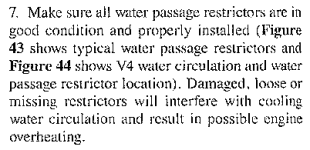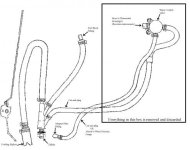Well,-----What does your factory manual say ?-------And does a parts breakdown of your motor show any diverters ??????------Note---- those head gaskets in post #25 are for a " crossflow " engine and you are working on a looper style engine.----Totally different machine.
Good question. The shop manual doesn't distinguish between Loop-charged and cross-flow blocks, with regard to diverter/restrictor installation. It only distinguishes between "typical water passage restrictor" and "V4 water circulation and waterpassage restrictor" locations.

Also, I don't see diverters listed here at marineengine.com for this motor, but I also don't consistently find it shown for some known crossflow engines, either. Some yes, some no, so it has helped me remain confused. :-D
You have a looper 100%....no diverters in block
Thanks for helping me nail that one down.
Is the water " control valve " still in operation on the side of the block , yes or no .
I can't give a yes-or-no answer. How would I determine this?
Did you do a compression test before teardown? Its been substantially overheated. This all might be an exercise in futility. The piston rings might have surrendered.
I had planned to. I tried to do the Advanced Auto tool loan, but they didn't have one to loan me. I will say, though, the engine runs really well. Good and smooth. Just getting hot. As for the scale in the water jacket... this motor has lived its entire life on the Gulf Coast - all salt & brackish water, so salt scale is par for the course. I'm cleaning it all up, as I go. Oh, BTW, the cylinder walls look good, too.
I'm starting to really scratch my head. I was hoping I had found the problem in the "missing" diverters/restrictors. That seems like a phantom at this point. I look forward to ferriting out the water control valve concern.



